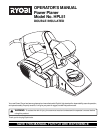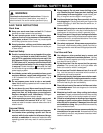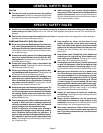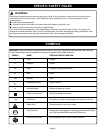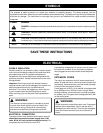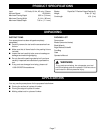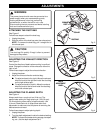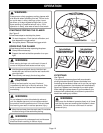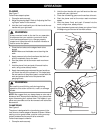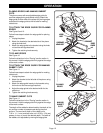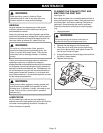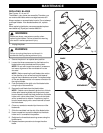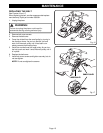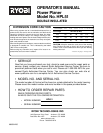
Page 11
OPERATION
Fig. 8
PLANING
See Figure 7.
Follow these steps to plane.
1. Clamp the work securely.
2. Adjust the planing depth. Refer to “Adjusting the Plan-
ing Depth” earlier in this manual.
3. Hold the front handle with your left hand and the rear
handle with your right hand.
WARNING:
Always use two hands on the tool for any operation;
this assures that you maintain control and avoid
risk of serious personal injury. Always properly
support and clamp the work so that both hands are
free to control the planer.
4. Place the front shoe on the edge of work to be
planed.
NOTE: Make sure the blades are not touching the
work.
5. Apply pressure to the front handle so that the front
shoe is completely flat on the work.
6. Start the planer and let the motor reach maximum
speed.
7. Hold the planer firmly and push it forward into the
work, using a slow, steady motion.
8. Apply downward pressure toward the rear handle as
you reach the end of the planed cut. This helps keep
the rear section of the planer base in contact with the
work and prevents the front of the planer from
gouging the cut.
WARNING:
Be careful to avoid hitting nails during planing
operation; this action could nick, crack, or damage
blades.
NOTE: We suggest that you always keep an extra set of
blades on hand. As soon as the blades in your planer show
signs of becoming dull, replace them. The blades in your
planer are reversible and can be reversed until both sides
become dull.
CHAMFERING
See Figure 8.
The planer is designed with a chamfering groove in the
front shoe to chamfer edges of boards as shown. Before
making a cut on good lumber, practice cutting on scrap
lumber to determine the amount to be removed.
Follow these steps to chamfer.
1. Clamp the work securely.
2. Hold the front handle with your left hand and the rear
handle with your right hand.
3. Place the chamfering groove on the surface to be cut.
4. Start the planer and let the motor reach maximum
speed.
5. Hold the planer firmly and push it forward into the
work, using a slow, steady motion.
6. Apply downward pressure to keep your planer flat at
the beginning and the end of the work surface.
Fig. 7
KICKSTAND



